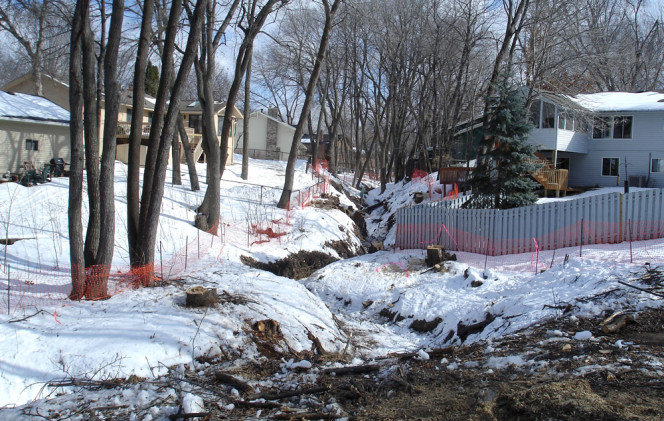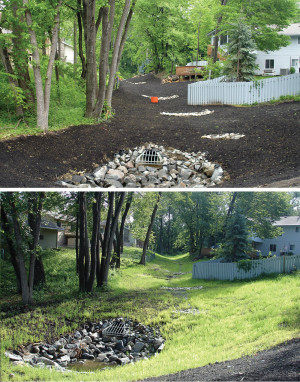Plymouth, Minnesota employs compost and native plants to restore stream banks, controlling erosion and preventing sediment runoff into the community’s lake.
Dan Emerson
BioCycle February 2015

Erosion on the upper portion of Wood Creek after tree removal in February 2008. Photo courtesy of City of Plymouth
Derek Asche, Water Resources Manager for the City of Plymouth, Minnesota, has a photo showing cable TV, phone and electrical cables protruding from eroding soil along Wood Creek, a stream that flows through a residential neighborhood in the Minneapolis suburb. Asche took the photo several years ago to show how erosion gradually removed the soil covering the formerly-buried cables.

In May 2008, contractors installed a small run of sewer pipe in the upper portion of Wood Creek as well as rocks for bank protection, and covered the project area (top) with a two to four inch compost blanket to control erosion and sedimentation, as well as serve as a growing medium (vegetation shown bottom). Photos courtesy of City of Plymouth
Today, the cables and wires are once again buried under several feet of earth, and the banks of the creek are covered with native vegetation that keeps the soil in place. The Wood Creek restoration is one of several projects in which city crews have used compost to restore and maintain public land in the suburb, most of which was developed back in the 1960s and 1970s.
Since 1991, local government agencies in Minnesota, such as the City of Plymouth, have had the responsibility of administering the state’s Wetland Conservation Act (WCA). “A big chunk of Plymouth has a lot of water flowing through it,” Asche explains. “We have these open streams and the (land-management) regulations significantly restrict putting in pipes to direct the flow, so, we need other solutions to be able to manage erosion issues that develop along some of the streams. At one time, the streams might have been going through prairie, but as the trees have grown and the neighborhoods have developed, it╒s gotten to be a very different management (challenge). Once they are in a state of disrepair, you have to have vegetative solutions to solve the erosion problem.”
Asche notes compost has been one of the key tools Plymouth has used in its ongoing effort to restore and protect drainage channels that lead to and from Medicine Lake — an 800-acre body of water in Hennepin County and one of the largest in the Twin Cities metro area — and nearby wetlands. Contractors hired by the city for the Medicine Lake project used Grade 2 leaf and yard trimmings compost with a 19 mm (3/4-inch) particle size (as defined in Minnesota Department of Transportation specifications), applied in depths of two to four inches, to filter and reduce the amount of runoff water draining into the lake.
Rain Gardens, Stream Bank Restoration
Since 2005, contractors for the City of Plymouth have used compost to build more than 30 rain gardens as part of street reconstruction projects in the residential neighborhoods that drain to the lake and surrounding wetlands. Compost used in the rain gardens is covered with mulch. Residents have certain expectations for what projects will look like when they are finished, which is a “positive” in this case, Asche says.
One major erosion problem had developed along Wood Creek, which flows in a westerly direction, into the east side of the lake. Over the years since the neighborhood was first developed in the late 1970s, trees grew up and “shaded out” plants along the banks that had helped hold soil in place. With a 40-foot drop along 1,600 linear feet extending to the lake, severe erosion developed over time, as deep as six to seven feet in places, notes Asche. Along with harming the water quality in the lake, “it was getting to the point where we were going to have infrastructure problems,” he says, citing the cables unearthed by the erosion. The eroding slopes were also threatening nearby fences, swimming pools and other backyard structures.
In the summer of 2008, the contractors were able to install a small run of storm sewer pipe within a portion of the Wood Creek project area, regrade portions of the creek, install rock for bank protection, and spread two to four inches of compost over the project area (in an average width of about 50 feet), to control erosion and sedimentation, and serve as a growing medium. The compost was installed on the upper half of the project area in late May and early June, and on the lower half in late June and early July.
After the project was announced, some residents of the area had initially expressed opposition to the use of compost, fearing odor problems. “They were along the lower end of the creek,” explains Asche. “To accommodate those concerns, we specified an erosion control blanket made from straw on that end. The upper end was finished first, including the area specified with compost, and the results were great.” When residents on the lower half of the project saw the pleasing appearance of the composted area, and lack of an odor problem, ╥we had to modify the plans (for the lower half),” he adds. “They insisted on having compost, for that ╘finished╒ look ╤ which was an easy accommodation to make.” Summer heat and dryness delayed the germination and growth on the lower half until early September but, says Asche, “in the fall when we got some moisture, that took off. The results were fantastic.”
Phosphorus Removal
During the winter of 2011-2012, the city undertook the restoration of Plymouth Creek, on the west side of Medicine Lake. The goal was to remove about 1,000 pounds of phosphorous per year from the 6,000-acre watershed, along with nitrogen and suspended solids. Compost was laid from two to four inches deep along approximately 3,000 linear feet of a 4,100 linear foot project, explains Asche. The contractor also strategically placed rocks to control the velocity of the flows and created buffers along the sides of the creek, using native plants with good root systems within the buffers. The rocks, buffers and native plants can reduce erosion along the creek, keeping in place the phosphorus that binds to such soil particles and preventing their transport downstream.
Another restoration project to reduce phosphorus loading and prevent downstream flooding was completed along Timber Creek, a roughly 1,000 foot long drainage-way, with a 30-foot drop in topography, leading to Medicine Lake. An outlet-control structure on an upstream pond had failed to control the rate of drainage through the area and was beginning to deteriorate, which led to erosion. Compost was laid two to four inches deep, and seeded with native plants to create a vegetative base, which developed fairly rapidly; in 75 days, the area went from “black to green.”
The city also used compost in an erosion control project in Nature Canyon, an environmentally sensitive area that includes a 30-acre wetland and a forest of nearly 75 acres. Located near Interstate 494, it’s a “hilly” area not suitable for development that is currently utilized as parkland. An environmental analysis indicated that the woods were valuable, because of the presence of oak and maple trees, and a lack of invasive, woody species “which is no longer common in the suburbs.”
The canyon extends 750 feet from the downstream wetland, with a gradual 40-foot drop from top to bottom, with runoff from the surrounding neighborhood draining into the “exceptional quality” wetland, Asche notes. Compost was placed to control erosion and sediment. Because of the sloping terrain, crews used a medium-duty coconut fiber blanket on top of the compost.
Asche says city crews will continue monitoring the conditions in the areas where projects have been completed. “It looks like we╒re protecting the water bodies from further degradation. What we want to see in the next five to 10 years is a steady improvement in water quality, now that we have reduced the amount of sediment and nutrient loading.”
Dan Emerson is a Contributing Editor to BioCycle. This article is based on a presentation by the City of Plymouth at a Compost Markets Workshop sponsored by the Minnesota Composting Council.













